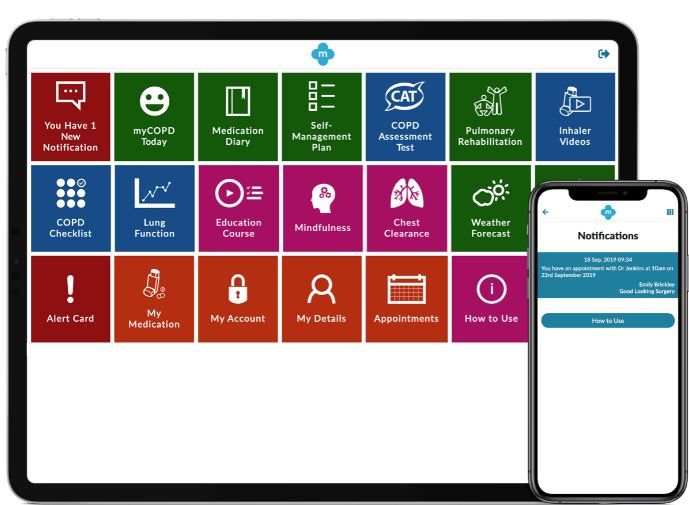- Clinical Technology
- Adult Immunization
- Hepatology
- Pediatric Immunization
- Screening
- Psychiatry
- Allergy
- Women's Health
- Cardiology
- Pediatrics
- Dermatology
- Endocrinology
- Pain Management
- Gastroenterology
- Infectious Disease
- Obesity Medicine
- Rheumatology
- Nephrology
- Neurology
- Pulmonology
COPD Self-management App Reduces Exacerbations, Readmissions vs Usual Care
Use of the myCOPD app after hospitalization for acute COPD exacerbation reduced subsequent exacerbations by nearly 50%, according to study authors.
A digital app designed for use by COPD patients upon hospital discharge after acute disease exacerbation reduced subsequent exacerbations by nearly half and also reduced hospital readmissions vs usual care, according to a recent study from the University of Southampton in the UK.

Compared with the standard written self-management plan currently provided to COPD patients after an exacerbation, the app, called myCOPD, also improved COPD inhaler technique and measures of disease control used to gauge post-discharge recovery. The findings were published in NPJ Digital Medicine.
Study authors note that in the UK alone there are more than 140 000 hospital admissions for COPD exacerbations annually, which translates to 100 million bed days; they cite a national audit showing that in one year the readmission rate for COPD patients was as high as 43% within 3 months of hospital discharge.
Lack of time and clinical resources have consistently thwarted efforts to improve self-management support in the critical weeks and months following an exacerbation.
Pointing to evidence for the success of digital exercise support programs in COPD and a digital pulmonary rehab intervention, the authors hypothesized that the digital mode could also be used to improve disease understanding, treatment adherence, and so, clinical outcomes following hospitalization.
The study randomized 41 patients who had been hospitalized with severe COPD exacerbations to 2 groups: 21 patients were randomized to treatment as usual (TAU) and 20 to the myCOPD app. Mean age was 66.6 years; 41% were female. COPD severity was identified as moderate (34%); severe (41%); and very severe (24%).
The primary efficacy outcome was recovery rate of symptoms measured by COPD assessment test (CAT) score. Exacerbations, readmission, inhaler technique, quality of life, and patient activation scores were also captured.
AT 90 days, the treatment effect on the CAT score was 4.49 (95% CI: −8.41, −0.58) points lower in the myCOPD arm. Patients’ inhaler technique improved in the digital intervention arm, with incorrect use reduced by approximately 80% for myCOPD users (101 critical errors improving to 20) compared to 30% (100 critical errors falling to 72) for the control group.
Exacerbations were nearly half as frequent in the digital arm vs usual care—34 vs 18 events.
Hospital readmissions risk was numerically lower in the myCOPD intervention arm. Data showed 4 (20%) hospital readmissions of any length in the myCOPD arm and 7 (33%) in the TAU arm. Odds ratio for readmission was 0.383 (95% CI: 0.074, 1.987; n = 35).
In a Southampton University press release, app developer Professor Tom Wilkinson said, “COPD has a significant impact on peoples’ daily lives so we wanted to develop a means of healthcare that is like having an expert in your pocket; giving you advice whenever you need it.” Professor Wilkinson also led the study.
“The transition towards digital healthcare has been taking place for some time but has accelerated since the outbreak of COVID-19. Patients with conditions such as COPD can be particularly vulnerable now so it is important that we have evidence of the effectiveness of these technologies.”
